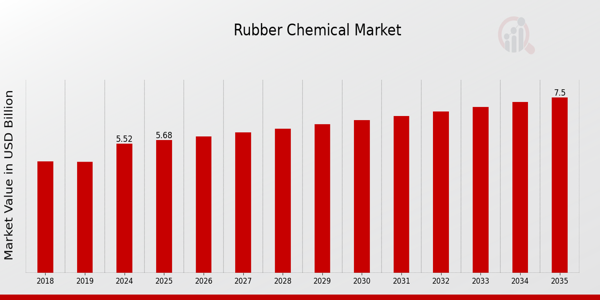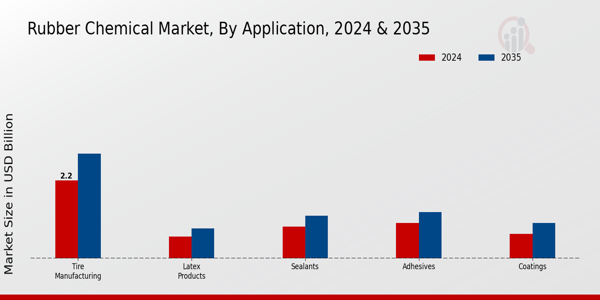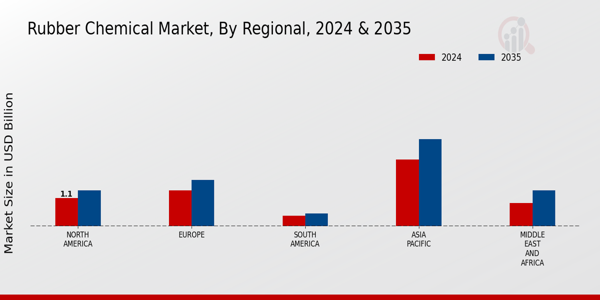Rubber Chemical Market Summary
As per Market Research Future Analysis, the Global Rubber Chemical Market was valued at 5.37 USD Billion in 2023 and is projected to grow to 7.5 USD Billion by 2035, driven by increasing demand in automotive and manufacturing sectors. The market is witnessing a shift towards sustainable and eco-friendly rubber products, with significant investments in R&D for bio-based and recyclable rubber chemicals. Innovations in production technologies are enhancing performance and durability, catering to diverse applications across industries.
Key Market Trends & Highlights
Key trends shaping the Rubber Chemical Market include:
- The market is expected to grow from 5.52 USD Billion in 2024 to 7.5 USD Billion by 2035, with a CAGR of 2.83% from 2025 to 2035.
- Tire Manufacturing is projected to increase from 2.2 USD Billion in 2024 to 3.0 USD Billion by 2035, highlighting its dominance in market revenue.
- The Automotive sector is crucial, with a steady recovery in vehicle production post-pandemic, driving demand for rubber chemicals.
- Technological advancements in rubber chemical production are leading to novel compounds that enhance performance across various applications.
Market Size & Forecast
2023 Market Size: USD 5.37 Billion
2024 Market Size: USD 5.52 Billion
2035 Market Size: USD 7.5 Billion
CAGR (2025-2035): 2.83%
Largest Regional Market Share in 2024: Asia Pacific.
Major Players
Key Companies include Solvay, DuPont, Hexpol, Lanxess, OMNOVA Solutions, Kraton Corporation, Eastman Chemical Company, AkzoNobel, Crompton Corporation, BASF, Wacker Chemie AG, Archer Daniels Midland Company, RTP Company, Sky NRG.
Key Rubber Chemical Market Trends Highlighted
There are a number of major industry trends happening right now in the Rubber Chemical industry. One big reason is that more and more sectors use rubber, especially the automotive, consumer products, and construction industries. The continued growth of infrastructure projects and the rise in car manufacturing throughout the globe are driving this increase in demand. Also, the drive for sustainability is having an effect on the market since firms are utilizing eco-friendly rubber compounds to attract customers who care about the environment and follow rules against dangerous chemicals.
One way to take advantage of the Rubber Chemical Market is to create new products that are both effective and environmentally friendly.
The usage of bio-based rubber compounds is becoming more common. These chemicals help minimize reliance on petroleum-based goods and make rubber production less harmful to the environment. The surge in electric vehicle manufacturing is another chance since these cars typically need unique rubber compositions. In recent years, sophisticated production technologies like automation and nanotechnology, which may make rubber goods work better, have become more popular. Regional partnerships are helping people share their expertise and technology, which may make products even better.
Also, the fact that more people are aware of the health effects of certain chemicals is pushing the business to choose safer alternatives.
These changes show that the Rubber Chemical Market is always changing and that innovation and sustainability are becoming more important for growth and development

Source: Primary Research, Secondary Research, Market Research Future Database and Analyst Review
Rubber Chemical Market Drivers
Increasing Demand from Automotive Industry
The Rubber Chemical Market Industry is significantly driven by the increasing demand from the automotive industry, which accounts for a substantial portion of rubber consumption. The automotive sector is expected to grow due to the rising production of vehicles. According to the International Organization of Motor Vehicle Manufacturers, car production reached approximately 95 million units in 2019, and with recovery post-pandemic, it is projected to surpass 100 million units by 2025.This growth directly influences the consumption of rubber chemicals, crucial for enhancing the performance and durability of tires and other automotive components.
Established automobile manufacturers are actively investing in Research and Development to improve rubber properties, thereby driving the demand for rubber chemicals ly. As per European Automobile Manufacturers Association, the European market for new cars alone showed a growth of around 10% in sales in 2021, further emphasizing the expanding requirement for rubber chemicals.
Growth in Construction and Infrastructure Sector
The construction and infrastructure sector is another significant driver for the Rubber Chemical Market Industry. With increasing urbanization and infrastructural development around the globe, the need for durable construction materials has risen. World Bank analysis indicates that infrastructure investment is projected to reach USD 94 trillion by 2040. The utilization of rubber in construction materials such as asphalt and sealants is growing due to its beneficial properties like flexibility and resistance to weathering.This contributes to the demand for rubber chemicals that enhance these materials' performance, driving the overall market.
Initiatives promoting sustainable construction practices also support this growth, resulting in more innovative rubber products.
Technological Advancements in Rubber Processing
Advancements in technology related to rubber processing are significantly propelling the Rubber Chemical Market Industry. New developments in processing techniques enhance the efficiency of rubber production by improving processing speeds and reducing waste. Data from the American Chemical Society suggests that innovations in rubber processing technology could increase production efficiency by up to 30% while lowering costs, which will enable manufacturers to supply higher quantities of rubber chemicals.Companies are increasingly focusing on Research and Development to optimize rubber compounds through innovative chemical formulations, ensuring enhanced performance and lower environmental impacts.
This trend towards sustainable technological improvements is gaining traction ly, significantly boosting the rubber chemicals market.
Rising Health and Environmental Regulations
The increasing stringency of health and environmental regulations is poised to benefit the Rubber Chemical Market Industry as it encourages the adoption of eco-friendly rubber chemicals. Governments around the world, including those in Europe and North America, are implementing stringent regulations to limit hazardous substances in industrial products. The European Chemicals Agency suggests that over 40% of rubber chemical manufacturers are investing in cleaner production technologies to comply with these regulations, thereby boosting demand for safer alternatives.
As manufacturers shift toward more sustainable and compliant rubber chemicals, it also opens avenues for innovation and enhances market growth, aligning with sustainability goals.
Rubber Chemical Market Segment Insights
Rubber Chemical Market Application Insights
The Rubber Chemical Market, particularly within the Application segment, is poised to demonstrate steady growth with a total projected market value of USD 5.52 Billion in 2024 and increasing to USD 7.5 Billion by 2035. This market segmentation highlights critical applications including Tire Manufacturing, Adhesives, Sealants, Coatings, and Latex Products, each contributing to the overall landscape of the industry.
Tire Manufacturing leads the segmentation, holding a substantial valuation of USD 2.2 Billion in 2024 and anticipated to grow to USD 2.95 Billion by 2035, indicating its major role in the demand for rubber chemicals.The growth of the automotive industry, combined with the increasing demand for durable and high-performance tires, solidifies this application as a significant growth driver in the Rubber Chemical Market. Adhesives is another critical segment, valued at USD 1.0 Billion in 2024 and projected to reach USD 1.3 Billion in 2035.
This application caters primarily to the construction and automotive sectors where strong bonding solutions are increasingly required, leading to a stable demand for rubber chemical products.
Sealants also play a crucial role, with a market valuation of USD 0.9 Billion in 2024, expected to rise to USD 1.2 Billion by 2035, often used in construction and automotive applications where providing effective barriers to moisture is essential.Coatings, valued at USD 0.7 Billion in 2024 and likely to rise to USD 1.0 Billion in 2035, account for a significant portion of the market as they are widely used in protective applications across various industries, enhancing product longevity.
Lastly, Latex Products, holding a market value of USD 0.62 Billion in 2024, are projected to grow to USD 0.85 Billion by 2035. This segment is crucial in the manufacturing of products such as adhesives and coatings due to the increasing preference for environmentally friendly products in various applications.Overall, the Application segment illustrates the diverse utility of rubber chemicals, driven by ongoing trends towards innovation in durability and performance, while navigating challenges such as raw material price fluctuations and regulations pertaining to chemical safety.
Each application is integral to the overall health and expansion of the Rubber Chemical Market, reflecting its adaptability to the dynamic needs of multiple industries on a scale, thus providing various opportunities for growth and investment.

Source: Primary Research, Secondary Research, Market Research Future Database and Analyst Review
Rubber Chemical Market Type Insights
The Rubber Chemical Market is projected to witness significant growth, with the market expected to reach a valuation of 5.52 USD Billion in 2024. The market is segmented into various types, including Anti-Degradants, Accelerators, Vulcanizing Agents, Fillers, and Antioxidants. Each segment plays a crucial role in enhancing rubber properties and performance. For instance, Anti-Degradants are vital for prolonging the lifespan of rubber products by protecting them from environmental factors.
Accelerators are essential in the rubber manufacturing process, as they speed up the vulcanization process, which is a critical step in rubber production.Vulcanizing Agents are significant as they improve strength and elasticity, while Fillers are commonly used to reduce production costs and enhance physical properties. Antioxidants serve to prevent oxidation, crucial for maintaining the durability of rubber products. Overall, the Rubber Chemical Market segmentation showcases diverse applications, all contributing to market resilience and growth in various industries such as automotive, industrial, and consumer goods, underscoring the importance of these chemicals in enhancing rubber performance and sustainability.
Rubber Chemical Market End Use Insights
The Rubber Chemical Market is projected to be valued at 5.52 billion USD in 2024, highlighting its substantial presence across various end-use sectors. The Automotive segment plays a pivotal role, driven by the increasing demand for tire production and automotive parts that require enhanced performance and durability. The Industrial sector also significantly contributes, where rubber chemicals are essential in manufacturing processes to improve material resilience.
In the Consumer Goods segment, the growing need for high-quality rubber in products such as footwear and household goods is evident.Meanwhile, the Construction sector benefits from rubber chemicals used in sealants, gaskets, and insulation materials, ensuring longevity and reliability in infrastructure projects. The Healthcare sector utilizes rubber chemicals in the production of medical devices and equipment, reinforcing the importance of safety and effectiveness in health-related applications.
Collectively, these segments underscore the robust Rubber Chemical Market dynamics, where each plays a significant role in driving demand, highlighted by factors such as increasing industrialization, urbanization, and advances in technology.This market continues to evolve, presenting opportunities tied to eco-friendly materials and innovations in rubber formulations that cater to diverse industry needs, ensuring continued growth and adaptation in the economy.
Rubber Chemical Market Form Insights
The Rubber Chemical Market is projected to be valued at 5.52 USD Billion in 2024, highlighting a continuous demand for various formulations used in rubber production. This market comprises different forms including Liquid, Solid, and Powder, each playing a vital role in the overall industry landscape. The Liquid form is essential for ensuring homogeneous distribution of chemicals within rubber compounds, while the Solid form often facilitates easier storage and handling, particularly in large volume applications.
Powdered chemicals, on the other hand, allow for precise dosing and are integral in specialty applications.As the industry evolves, trends such as the increasing use of eco-friendly rubber chemicals and the growing automotive sector drive the demand for these forms. With the continuous expansion of manufacturing capabilities ly, the importance of diverse forms in enhancing rubber performance characteristics will likely play a crucial role in shaping the future dynamics of the Rubber Chemical Market. The expected statistics and insights underscore a balanced growth trajectory across these components, driven by innovation and expansion in application areas.
Rubber Chemical Market Regional Insights
The Rubber Chemical Market is projected to reach a valuation of 5.52 USD Billion in 2024, showcasing a diverse segmentation across various regions. North America, holding a value of 1.1 USD Billion, is significant due to its robust automotive industry, which drives demand for rubber chemicals. Europe, valued at 1.4 USD Billion, also plays a crucial role, driven by stringent regulations that enhance the need for eco-friendly rubber solutions.
The Asia Pacific region leads significantly with a valuation of 2.6 USD Billion owing to rapid industrialization and growing automotive sectors, thus dominating the market landscape.In South America, the market stands at 0.4 USD Billion, which is growing slowly but steadily as rubber production increases in conjunction with agricultural demand. Meanwhile, the Middle East and Africa present a valuation of 0.9 USD Billion, showing potential growth as construction and automotive sectors expand.
Overall, the Rubber Chemical Market segmentation underlines the importance of regional dynamics in shaping market growth and trends, with the Asia Pacific region leading the majority holding, while other regions like North America and Europe also maintain significant positions due to industrial advancements and regulatory frameworks.

Source: Primary Research, Secondary Research, Market Research Future Database and Analyst Review
Rubber Chemical Market Key Players and Competitive Insights
The Rubber Chemical Market is a dynamic sector characterized by diverse players and a competitive landscape that continuously evolves due to technological advancements, changing consumer preferences, and regulatory frameworks. Key players in this market focus on innovation and the development of specialized rubber chemicals that enhance the performance and durability of rubber products across various industries. The competition is not only about product offerings but also involves strategic partnerships, mergers and acquisitions, and geographical expansion to capture emerging markets.
Companies are increasingly investing in research and development to introduce sustainable and eco-friendly rubber chemicals that meet the growing demand for environmentally responsible products. This competitive insight reveals an ongoing effort among industry players to establish a stronghold in a market that is crucial for numerous applications, including automotive, consumer goods, and industrial sectors.
Key Companies in the Rubber Chemical Market Include
- Cabot Corporation
- Kraton Corporation
- Wacker Chemie
- Aditya Birla Chemicals
- Eastman Chemical Company
- BASF
- Lanxess
- Solvay
Rubber Chemical Industry Developments
-
Q2 2024: Reliance Sibur Elastomers Private Limited inaugurates new butyl rubber plant in Jamnagar, Gujarat Reliance Sibur Elastomers Private Limited, a joint venture between Reliance Industries and SIBUR, opened a new butyl rubber manufacturing facility in Jamnagar, Gujarat, with an annual capacity of 120,000 metric tonnes, aimed at reducing India's reliance on imports and supporting domestic automotive and industrial sectors.
Rubber Chemical Market Segmentation Insights
Rubber Chemical Market Application Outlook
- Tire Manufacturing
- Adhesives
- Sealants
- Coatings
- Latex Products
Rubber Chemical Market Type Outlook
- Anti-Degradants
- Accelerators
- Vulcanizing Agents
- Fillers
- Antioxidants
Rubber Chemical Market End Use Outlook
- Automotive
- Industrial
- Consumer Goods
- Construction
- Healthcare
Rubber Chemical Market Form Outlook
Rubber Chemical Market Regional Outlook
- North America
- Europe
- South America
- Asia Pacific
- Middle East and Africa
| Report Attribute/Metric |
Details |
| Market Size 2023 |
5.37(USD Billion) |
| Market Size 2024 |
5.52(USD Billion) |
| Market Size 2035 |
7.5(USD Billion) |
| Compound Annual Growth Rate (CAGR) |
2.83% (2025 - 2035) |
| Report Coverage |
Revenue Forecast, Competitive Landscape, Growth Factors, and Trends |
| Base Year |
2024 |
| Market Forecast Period |
2025 - 2035 |
| Historical Data |
2019 - 2024 |
| Market Forecast Units |
USD Billion |
| Key Companies Profiled |
Cabot Corporation, Kraton Corporation, Wacker Chemie, Aditya Birla Chemicals, Eastman Chemical Company BASF, Lanxess, Solvay |
| Segments Covered |
Application, Type, End Use, Form, Regional |
| Key Market Opportunities |
Sustainable rubber production technologies, Growing demand for green tires, Expansion in automotive sector, Innovations in bio-based chemicals, Increasing demand from construction industry |
| Key Market Dynamics |
Increasing automotive production, Rising demand for tires, Stringent environmental regulations, Technological advancements in manufacturing, Growth in construction industry |
| Countries Covered |
North America, Europe, APAC, South America, MEA |
Frequently Asked Questions (FAQ):
The Rubber Chemical Market is expected to be valued at 7.5 USD Billion by 2035.
The Rubber Chemical Market is anticipated to grow at a CAGR of 2.83% from 2025 to 2035.
Tire Manufacturing holds the largest market share with a valuation of 2.2 USD Billion in 2024.
The market value for Adhesives is expected to reach 1.3 USD Billion by 2035.
In 2024, the market values by region include North America at 1.1 USD Billion, Europe at 1.4 USD Billion, Asia Pacific at 2.6 USD Billion, South America at 0.4 USD Billion, and Middle East and Africa at 0.9 USD Billion.
The Rubber Chemical Market is valued at 5.52 USD Billion in 2024.
Major players include Kraton Corporation, Cabot Corporation, and BASF among others.
The projected market value for Sealants is expected to be 1.2 USD Billion by 2035.
The Asia Pacific region is expected to grow to 3.4 USD Billion by 2035.
The Tire Manufacturing sub-segment is expected to see significant growth, with values projected to reach 2.95 USD Billion by 2035.

















